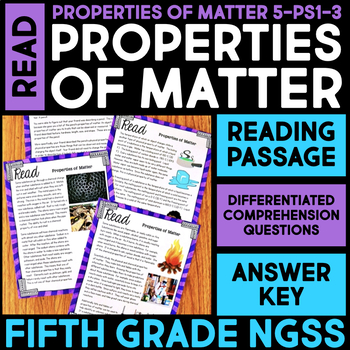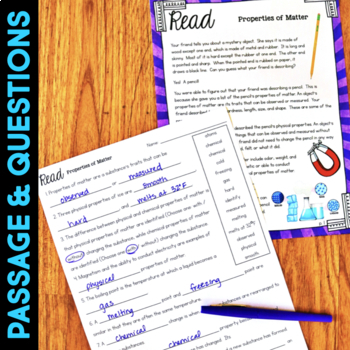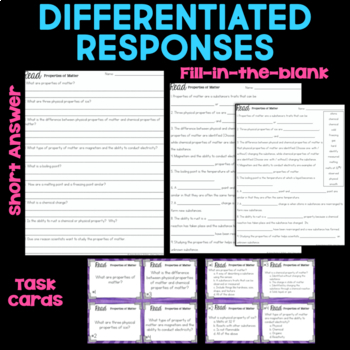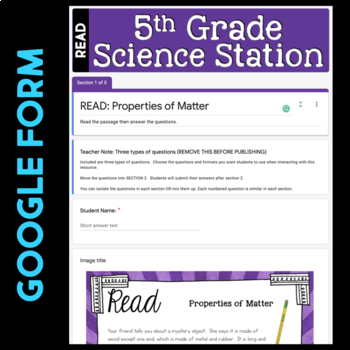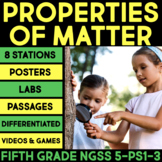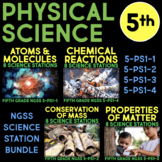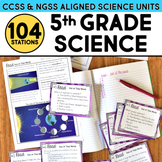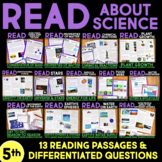READ about Properties of Matter Station - 5th Grade Science Reading Passage NGSS
- PDF
- Google Apps™
- Internet Activities
- Easel Activity
- Easel Assessment

Also included in
- These Properties of Matter Science Centers include eight different science stations where students deepen their understanding of the properties of matter, including making observations and measurements to identify materials based on their properties. They meet the Next Generation Science Standards fPrice $17.00Original Price $24.55Save $7.55
- This is BUNDLE of ALL of the 5th grade NGSS science stations for physical science, Matter and Its Interactions. It includes 32 Science Stations that focus on atoms and molecules, the conservation of mass, properties of matter, and chemical reactions.Included in this bundle are:Atoms and Molecules 5Price $45.00Original Price $98.70Save $53.70
- This is a Yearlong BUNDLE of ALL of the 5th-grade Science Stations aligned with the NGSS. There are multiple science stations for each of the Next Generation Science Standards for Fifth Grade for a total of 104 science stations.THIRTEEN Science Topics that cover all the NGSS for fifth gradeEIGHT stPrice $192.50Original Price $335.94Save $143.44
- Do your students need help with reading comprehension in science? This Read a Passage Science BUNDLE is just what you need! It includes 13 reading passages and differentiated questions for each passage. Students answer questions about the reading passage within their science journals, on the includePrice $29.00Original Price $43.60Save $14.60
Description
In this READ science station, students read a passage about the properties of matter. Students then answer questions about the passage within their science journals, on the included worksheets, or in the Google From™️.
Included in this resource:
- Teacher Notes
- Student Text in two formats
- Differentiated Questions (short answer, fill-in-the-blank with and without a word bank, task cards, multiple-choice questions)
- Answer Key
- Google Form™️ with Reading Text & Differentiated Questions
DIFFERENTIATED SCIENCE COMPREHENSION QUESTIONS
Each station includes four different ways to respond to the experience at the station:
- short answer questions
- fill-in-the-blank questions with a word bank
- fill-in-the-blank questions without a word bank
- task cards with short answers
- task cards with multiple-choice
All the variations are similar. Choose the format that best fits your classroom and students. Students are encouraged to use their science journals, but worksheets are also included.
This READ station is also available in a discounted bundle of 8 stations.
Information about the full bundle
These Properties of Matter Next Generation Science Stations include eight different science stations where students deepen their understanding of the properties of matter, including making observations and measurements to identify materials based on properties. The focus is on 5-PS1-3.
Properties of Matter Stations Include
► Vocabulary Cards in two formats with and without pictures (only available in the BUNDLE)
► Big Idea Posters to display in your classroom (only available in the BUNDLE)
► Checklists for teachers and students (only available in the BUNDLE)
► Watch a Video - Students watch one of two videos about properties of matter or wood, water, and properties. They will answer questions in order to reinforce what they have learned. (Google Form™️ available)
► Play a Game - Students play a board game with other students or do a crossword or word search puzzle. The crossword and word search puzzles are available digitally.
► Investigate Mystery Material - Students read about the properties of matter. They conduct an investigation to identify a substance based on the observed properties of matter. They answer questions in order to reinforce what they have learned. (Google From™️ and Google Slides™️ are available)
► Diagram Classifying Properties - Students read about the properties of matter. They create their own diagram of physical properties based on the reading section. Students then answer questions in order to reinforce what they have learned. (Google From™️ and Google Slides™️ are available)
► Read about Properties of Matter - Students read about properties of matter. They answer questions in order to reinforce what they have learned. (Google From™️ is available)
► Model a Table of Properties - Students read about the properties of matter. They create a table of properties of matter and then model how it is used. They answer questions in order to reinforce what they have learned. (Google From™️ and Google Slides™️ are available)
► Explore Magnetic and Electric Properties - Students read about magnetic and electric properties of matter and explore whether objects have those properties. They answer questions in order to reinforce what they have learned. (Google From™️ and Google Slides™️ are available)
► Sort Physical or Chemical Property - Students read about the properties of matter. They will sort materials into two categories. They will then answer questions in order to reinforce what they have learned. (Google From™️ and Google Slides™️ are available)
Each station is designed to last about 15-20 minutes. The Explore station requires additional time for the solution to change. Students may do one a day for eight days, two a day for four days, or any format that works for your classroom. Because there are additional activities for the Watch and Play stations, you can offer those as a choice within that station or offer them as an early finisher station, as well.
NGSS Alignment
As a Fifth Grade Performance Expectation, students are expected to “Make observations and measurements to identify materials based on their properties.” (5-PS1-3). This correlates with the DCI 5-PS1.A, which states, “Measurements of a variety of properties can be used to identify materials. (Boundary: At this grade level, mass and weight are not distinguished, and no attempt is made to define the unseen particles or explain the atomic-scale mechanism of evaporation
and condensation.)” All stations in this set meet the Performance Expectation and DCI, helping students gain an understanding of how materials can be identified based on chemical and physical properties of matter.
Special Note: None of these stations give an exhaustive list of all the chemical and/or physical properties of matter. Knowing all of the types of properties is not important, especially at this level. What is important is being able to distinguish between physical properties of matter and chemical properties of matter: Physical properties of matter are those properties that can be observed and measured without changing the substance. Chemical properties of matter, on the other hand, can only be observed and measured by changing the substance.
The NGSS are three-dimensional. These stations meet:
- Performance Expectation: 5-PS1-3
- Disciplinary Core Idea: PS1.A: Structure and Properties of Matter
- Science and Engineering Practices: Planning and Carrying Out Investigations
- Crossing Cutting Concepts: Scale, Proportion, and Quantity: Natural objects exist from the very small to the immensely large.
See the preview for additional information and details about all of the stations.
___________________________________________________________________________
CLICK HERE TO FOLLOW ME ON TPT | CLICK HERE TO CHOOSE A FREE RESOURCE
TERMS OF USE
Copyright © What I Have Learned, Jessica Boschen
Permission to copy for single classroom or homeschool family use only.
This product may not be distributed or displayed digitally for public view.
Please purchase additional licenses if you intend to share this product.

